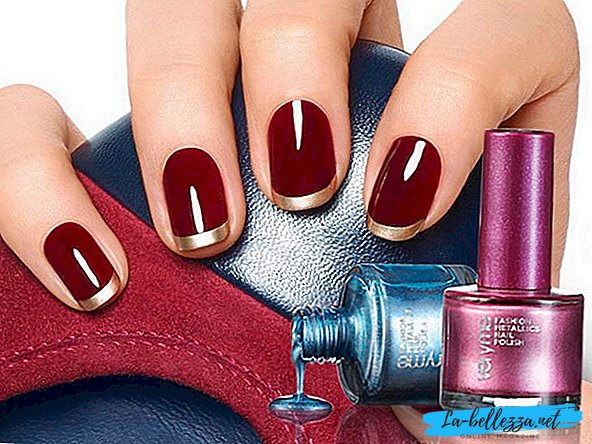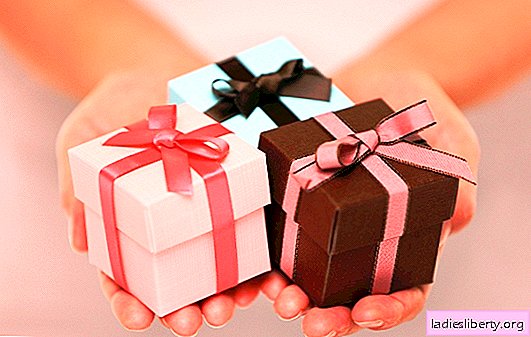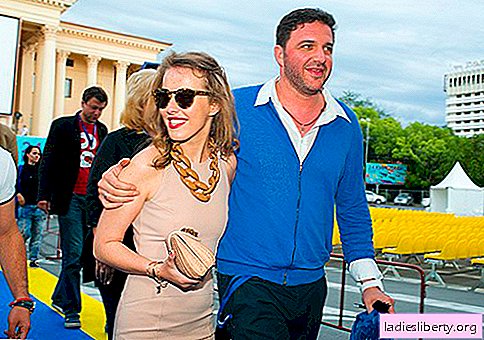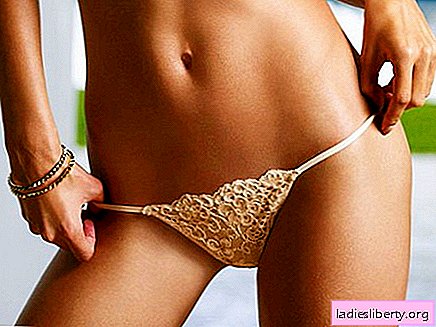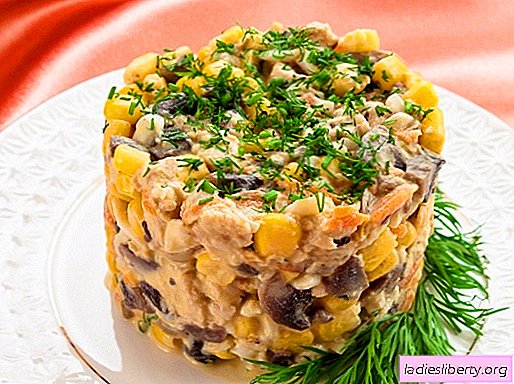
Every beginning needlewoman wants to master knitting. Knitting patterns will come easy if you start from scratch, so start learning needlework with the simplest patterns, then boldly proceed to more complex and interesting options. We have collected for you a lot of interesting ideas, ranging from the most simple.
Simple patterns of facial and purl loops with pictures
Simple beautiful sweaters, mittens, blouses, socks, hats, cardigans, tunics, pullovers and vests are knitted with just these simple patterns, which even lazy needlewomen will cope with. And jacquard patterns in combination with such lungs will be able to decorate absolutely any thing.
Stockinet

- 1 row: all loops are facial;
- 2 row: all loops purl.
Shawl from thick yarn with a detailed description

 | Facial loop in the front row or purl loop in the purl row. |
 | The back loop in the front row or the front loop in the back row. |
- 1 row: facial;
- 2 row: facial.
All rows are knitted with face loops. When knitting in a circle, one row is knitted with facial and the second with purl.
Rice (Moss) for jackets

The pattern is bilateral, loose and stretching. To perform the sample recruited on the spokes an even number of loops.
- 1 row: * 1 front, 1 purl *;
- 2 row: * 1 purl, 1 front *.
Next, the pattern is repeated from the first row. Thus, the facial loop lying on the needle, knit purl, and purl - face.
Technique holes

For a sample of a pattern, a number of loops, divisible by 12, plus 2 loops for the symmetry of the pattern, plus 2 edge loops, are drawn on the spokes.
 | Facial loop in the front row or purl loop in the purl row. |
 | Two loops together knit facial loop, picking up the loop at the back (behind the needle). The hinges are pre-rotated. |
 | Cape The end of the right needles seize the working thread from bottom to right, to itself. Nakid make for education azhura. |
- 1 row: * nakid, 2 loops together knit the front of the back walls (each loop is pre-rotated), 10 face *, nakid, 2 loops together knit the front of the back walls;
- 2 row and all even rows knit with purl;
3, 5, 7, 9 rows: all loops are facial; - 11 row: * 6 front, nakid, 2 loops together knit the front of the rear walls (loops are pre-rotated), 4 front *, 2 front.
- 13, 15, 17, 19 rows: all loops are facial.
Further the pattern repeats from the first row.
Purl stripes

 | Facial loop in the front row or purl loop in the purl row. |
 | The back loop in the front row or the front loop in the back row. |
- 1 row: all loops are facial;
- 2 row: all loops purl;
- 3 row: facial;
- 4 row: purl;
- 5 row: facial;
- 6 row: purl;
- 7 row: purl;
- 8 row: facial.
Next, the pattern repeats from the first row.
Strokes

 | Facial loop in the front row or purl loop in the purl row. |
 | The back loop in the front row or the front loop in the back row. |
For the pattern of the pattern, a number of loops is made on the spokes, a multiple of 12 plus 6 loops for the symmetry of the pattern plus 2 edge loops.
- 1, 3, 7 and 9 rows: all loops are facial;
- 2 and all the even rows: they knit according to a pattern, i.e., knit the loops as they lie on the spoke;
- 5 row: * 6 purl, 6 facial *, 6 purl;
- 11 row: * 6 facial, 6 purl *, 6 facial.
- 13 row knit as 1 row and so on.
Simple number 1

 | Facial loop in the front row or purl loop in the purl row. |
 | The back loop in the front row or the front loop in the back row. |
For the pattern of the pattern, a number of loops is made on the spokes, a multiple of 5 plus 2 edge loops.
- 1 row: * 4 facial, 1 purl *;
- 2 row and all purl rows knit with purl loops;
- 3rd row: * 1 purl, 4 facial *;
- 5 row: * 1 facial, 1 purl, 3 facial *;
- 7 row: * 2 facial, 1 purl, 2 facial *;
- 9 row: * 3 facial, 1 purl, 1 facial *.
Next, the pattern is repeated from the first row.
Simple number 2

 | Facial loop in the front row or purl loop in the purl row. |
 | The back loop in the front row or the front loop in the back row. |
Dense pattern of fine knitting, elastic, weakly stretched both along and across. The texture resembles the fabric, so it could also be attributed to the fabric patterns. For the sample, an even number of loops is drawn on the spokes.
- 1 row: * 1 front, 1 purl *;
- 2 row and all even rows: all loops are purl;
- 3 row: * 1 purl, 1 front *;
Further the pattern repeats from the first row.
Narrow colored rhombuses

 | Facial loop in the front row or purl loop in the purl row. |
 | The back loop in the front row or the front loop in the back row. |
This simple pattern is connected by face and purl loops. The pattern is double-sided, it looks the same from the front and the reverse side. For the pattern of the pattern gain the number of loops, a multiple of 8, plus two edge loops.
- 1 row: * 4 purl, 4 facial *;
- 2 row: * 3 purl, 4 front, 1 purl *;
- 3rd row: * 2 facial, 4 purl, 2 facial *;
- 4 row: * 1 purl, 4 facial, 3 purl *;
- 5 row: * 4 facial, 4 purl *;
- 6 row: * 4 purl, 4 facial *;
- 7 row: * 1 front, 4 purl, 3 front *;
- 8 row: * 2 purl, 4 facial, 2 purl *;
- 9 row: * 3 facial, 4 purl, 1 facial *;
- 10 row: * 4 facial, 4 purl *.
The pattern is repeated from the first row.
Rubber bands
There are a huge number of rubber bands, which were invented by the best craftsmen.
Simple gum 1 × 1

 | Facial loop in the front row or purl loop in the purl row. |
 | The back loop in the front row or the front loop in the back row. |
For the sample recruit an even number of loops. Gum knit facial and purl first (main) way. The first row of knitted alternating facial and purl loops, then knitting overturn and knit loops as they lie on the spoke - facial facial, purl of purl.
Record gum designation rapport can be represented as follows:
- 1 row: * 1 front, 1 purl *;
- 2 row: * 1 purl, 1 front *.
Simple 3 × 2 gum

 | Facial loop in the front row or purl loop in the purl row. |
 | The back loop in the front row or the front loop in the back row. |
For the sample, a number of loops, divisible by 5, plus 2 edge loops, are drawn on the spokes. The first row is knitted like this: three facial, two purl. Then knitting overturn and knit loops such as they lie on the knitting needle: facial facial, purl and purl.
- 1 row: * 3 facial, 2 purl *;
- 2 row: * 2 facial, 3 purl *.
You can create your own gum by alternately alternating the paths of the front and back loops.
English gum for scarves

 | Cape The end of the right needles seize the working thread from bottom to right, to itself. Nakid make for education azhura. |
 | Two loops together knit facial loop, picking up the loop in front (top). |
 | Remove the loop from the left to the right knitting needle unbound. Working thread for the needle (rear). |
- 1 row: * nakid (before the first loop), 1 loop remove, 2 loops together knit the front, picking up the loops in front *; The pattern is two-sided, it is used for knitting hats, scarves and warm sportswear. English gum is quite loose and voluminous, it stretches well. For knitting a knitting pattern, the number of loops is divided into three.
- The 2nd row and all subsequent rows are knitted as the first, but not two loops together, but a pair of nakid loops.
Convex elastic 2 x 2

Convex gum looks good on volumetric things. Circular knitting needles can be linked to the original snood-yoke, as in the Missoni collection. Seamless scarves are now particularly popular.
 | Cape The end of the right needles seize the working thread from bottom to right, to itself. Nakid make for education azhura. |
 | Two loops together knit facial loop, picking up the loop in front (top). |
 | Remove the loop from the left to the right knitting needle unbound. Working thread for the needle (rear). |
 | No loop on the circuit. |
- 1 row: * nakid, 1 loop is removed, nakid, 1 loop is removed, 2 loops together front, 2 loops together facial *;
- 2 row: * nakid, 1 loop is removed, nakid, 1 loop is removed, 2 loops together (nakid and loop of the previous row) front, 2 loops together (nakid and loop of the previous row) front *.
French gum for original scarves

 | Facial loop in the front row or purl loop in the purl row. |
 | The back loop in the front row or the front loop in the back row. |
- 1 row: * 2 facial, 2 purl *;
- 2nd row: * 1 purl, 2 facial, 1 purl *.
Cartridge belt

 | Facial loop in the front row or purl loop in the purl row. |
 | The back loop in the front row or the front loop in the back row. |
 | Remove the loop from the left to the right knitting needle unbound. Working thread in front of the needle (in front). |
- 1 row: * 3 facial, 1 loop untied, thread before work *, 3 facial;
- 2nd row: 1 front, 1 loop untied, thread before work, 1 face, * 2 front, 1 loop untied, thread before work, 1 face *.
Pearl Gum

 | Facial loop in the front row or purl loop in the purl row. |
 | Two loops together knit facial loop, picking up the loop in front (behind the front wall). |
 | Cape The end of the right needles seize the working thread from bottom to right, to itself. Nakid make for education azhura. |
 | No loop on the circuit. |
- 1 row: * nakid, 1 loop to remove (thread at work), 1 front *;
- 2 row: * 1 loop purl, 1 loop together with nakida knit front *.
Scottish gum

 | Facial loop in the front row or purl loop in the purl row. |
 | The back loop in the front row or the front loop in the back row. |
 | Cape The end of the right needles seize the working thread from bottom to right, to itself. Nakid make for education azhura. |
 | Loop thrown over. The end of the left spokes capture the loop (or nakid) and pull into it the next two loops. |
 | No loop on the circuit. |
- 1 row: * 2 facial, 1 purl *;
- 2 row: * 1 front, nakid, 2 front, nakid throw over the last two facial loops *.
Relief patterns
Patent pins

 | Facial loop in the front row or purl loop in the purl row. |
 | The back loop in the front row or the front loop in the back row. |
- 1, 3 and - 5 rows: * 4 facial, 2 purl *, 4 facial;
- 2, 4 and 6 rows: 4 purl * 2 facial, 4 purl *;
- 7 and 9 rows: 3 purl * 1 facial, 2 purl, 1 facial, 2 purl *, 1 purl;
- 8 and 10 rows: 1 front, * 2 front, 1 back, 2 front, 1 back *, 3 front;
- 11, 13, 15 rows: 3 purl, * 4 front, 2 purl *, 1 purl;
- 12, 14, 16 rows: 1 front, * 2 front, 4 purl * 3 front.
Honeycomb

 | Facial loop in the front row or purl loop in the purl row. |
 | The back loop in the front row or the front loop in the back row. |
 | Two loops together knit facial loop, picking up the loop in front (top). |
 | Cape The end of the right needles seize the working thread from bottom to right, to itself. Nakid make for education azhura. |
 | Remove the loop from the left to the right knitting needle unbound. Working thread for the needle (rear). |
 | Remove the loop from the left to the right knitting needle unbound. Working thread in front of the needle (in front). |
 | No loop on the circuit. |
- 1 row: * 1 loop purl, 1 loop front *;
- 2 row: * 1 purl, nakidy, 1 loop is removed *;
- 3rd row: * 1 front, remove the caps from the left to the right needle without knitting (thread behind), 1 front *;
- 4 row: * 1 purl, nakid the previous row removed from themselves (the thread in front of the needle), 1 purl *;
- 5 row: * 2 loops together knit front, 1 purl *;
- 6 row: * nakid, loop removed, 1 purl;
- 7 row: * 2 loops front, remove the cap (thread back) *;
- 8 row: * nakid remove from themselves (the thread in front), 2 purl *;
- 9 row: * 1 purl, 2 loops together knit the front *;
Next, repeat the pattern repeat with 2 rows.
Seashells

 | Facial loop in the front row or purl loop in the purl row. |
 | The back loop in the front row or the front loop in the back row. |
 | Of the five loops knit five. |
- 1st and 5th rows: all loops are facial;
- 2 and 6 rows: all loops are facial;
- 3 row: * from 5 loops to form 5, 1 front *, from 5 loops to form 5;
- 4th and 8th rows: all loops are purlable;
- 7 row: 3 loops are facial, * from 5 loops form 5, 1 facial *, 2 loops are facial.
Next, the pattern is repeated with 1 row.
Inclined strips for strap

 | Facial loop in the front row or purl loop in the purl row. |
 | The back loop in the front row or the front loop in the back row. |
 | 2 loops cross to the right. First, knit the 2nd loop with the right-hand knitting needle, pick it up from the front side of the knitting and, without removing the loops from the knitting needle, knit the 1st loop, and both loops are removed from the left-hand knitting needle. |
 | 2 loops cross to the left. First, knit the 2nd loop with the front loop, pick it up from behind (behind the knitting needle), and without removing the loop from the knitting needle, knit the 1st loop. |
For the sample, a number of loops, a multiple of 6, plus two edge ones, are drawn on the spokes.
- 1 row: * 1 purl, 2 cross loops to the right, 2 cross cross loops to the left, 1 purl *;
- 2nd row: * 1 facial, 4 purl, 1 facial *;
- 3rd row: cross the 2 loops to the right, cross the 2 loops to the left, 1 purl, * 1 purl, 2 loops to cross to the right, 2 loops to cross to the left, 1 purl *, 1 purl;
- 4 row: 1 facial, * 1 facial, 4 purl, 1 facial *, 1 facial, 4 purl;
- 5 row: 1 cross, 2 loops to cross to the left, 1 purl, * 1 purl, 2 to cross loops to the right, 2 loops to cross to the left, 1 purl * 1 to the purl, 1 face;
- 6 row: 1 purl, 1 facial * 1 facial, 4 purl, 1 facial *, 1 facial, 3 purl;
- 7 row: 2 loops to cross to the left, 1 purl, * 1 purl, 2 loops to cross to the right, 2 loops to cross to the left, 1 purl *, 1 purl, 2 loops to cross to the right;
- 8 row: 2 purl, 1 facial, * 1 facial, 4 purl, 1 facial *, 1 facial, 2 purl;
- 9th row: 1 front, 1 purl, * 1 purl, 2 loops to cross to the right, 2 loops to cross to the left, 1 purl *, 1 purl, 2 loops to cross to the right, 1 front;
- 10 row: 3 purl, 1 facial, * 1 facial, 4 purl, 1 facial *, 1 facial, 1 purl;
- 11th row: 1 purl, * 1 purl, 2 cross loops to the right, 2 cross loops to the left, 1 purl *, 1 back, 2 cross loops to the right, 2 cross loops to the left;
- 12 row: 4 purl, 1 facial, * 1 facial, 4 purl, 1 facial *, 1 facial.
Then continue to knit from the first row.
Relief pattern Leaves №1

 | Facial loop in the front row or purl loop in the purl row. |
 | The back loop in the front row or the front loop in the back row. |
 | Interception from one front and two purl loops with a slope to the left. The 1st loop is removed forward on an additional knitting needle. The 2nd and 3rd loops are knitted with purl, and then the loop with additional spokes of the front. |
 | Interception from one front and two purl loops tilted to the right. The 1st and 2nd loops are removed back on the additional knitting needle. The 3rd loop is knitted with a face, and then the 1st and 2nd loops with additional knitting needles. |
For a sample of a pattern, a number of loops, a multiple of 6, plus 2 edge ones, are drawn on the spokes.
- 1 row: * 2 purl, 2 facial, 2 purl *;
- 2 row and all even rows knit according to the pattern;
- 3rd row: * 2 loops are transferred to the auxiliary knitting needle at work, the 3rd loop is knitted with the front one, then 2 loops with the auxiliary knitting needle with the wrong side, the 4th loop is transferred forward to the additional knitting needle, 5 knit and 5th loop are knitted
- 4th facial *;
- 5 row: * 1 loop front, 4 purl, 1 front *;
- 7 row: * the 1st front loop is transferred forward to the additional knitting needle, the 2nd and 3rd loop are knitted with the wrong side, and then the 1st front loop, the 4th and 5th loop are transferred back to the additional needle, the 6th knit frontal then 4 and 5th purl.
The pattern is repeated from the first row.
Basket

 | Facial loop in the front row or purl loop in the purl row. |
 | The back loop in the front row or the front loop in the back row. |
 | Wrapping loop. Pull the wrap loop from the gap between the 4th and 5th loops, transfer the clasping loop to the left knitting needle and tie it together with the 1st loop of the front one, the rest of the loops are from the group of clenched knit ones. |
- 1 row: * 1 front, 2 loops purl, 1 front, 2 loops purl *; 1 front, 2 loops purl, 1 front;
- 2nd row: 1 purl, 2 loops are facial, 1 is purl, * 2 loops are facial, 1 is purl, 2 are facial, 1 is purl *;
- 3 row: pull the grasping loop from the gap between the 4th and 5th loops, transfer the grasping loop to the left needle and tie it together with the 1st loop of the face, the rest of the loop from the group of clenched knit the face, 2 purl *, again pull the arm loop and knit it together with the 1st loop (in the new group of clenched loops);
- 4 and 6 rows: 1 purl, 2 facial, 1 purl * 2 facial, 1 purl, 2 facial, 1 purl *,
- 5 row: * 1 front, 2 loops back, 1 front, 2 loops back *; 1 front, 2 loops purl, 1 front;
- 7 row: 1 front, 2 purl, * stretch the grasping loop from the gap between the 7th and 8th loops and tie it together with the 4th loop (similarly as in the 3rd row), 2 purl *, 1 facial.
Wave

The waves look very original on plaids and blankets.
 | Facial loop in the front row or purl loop in the purl row. |
 | The back loop in the front row or the front loop in the back row. |
 | Two loops together knit facial loop, picking up the loop in front (top). |
 | Two loops together knit facial loop, picking up the loop at the back (behind the needle). The hinges are pre-rotated. |
 | Cape The end of the right needles seize the working thread from bottom to right, to itself. Nakid make for education azhura. |
To perform a pattern of a pattern, dial the number of loops, a multiple of 11 plus 2 edge loops.
- 1 row: * 2 loops knit together the front of the back wall, 3 front, nakid, 1 front, nakid, 3 front, 2 loops together the front of the front wall *;
- 2, 4, 6, 8, 10, 11, 13 row: all loops are purl,
- 3, 5, 7, 9 row: knit the same way as the 1st row;
- 12, 14 row: all loops are facial.
Раппорт узора соствляет 14 рядов, 15-ый ряд вяжут как и первый и так далее.
Тканевые узоры
Узор №1

Для образца узора на спицы набирают четное число петель.
 | Лицевая петля в лицевом ряду или изнаночная петля в изнаночном ряду. |
 | Из двух петель провязать две. |


